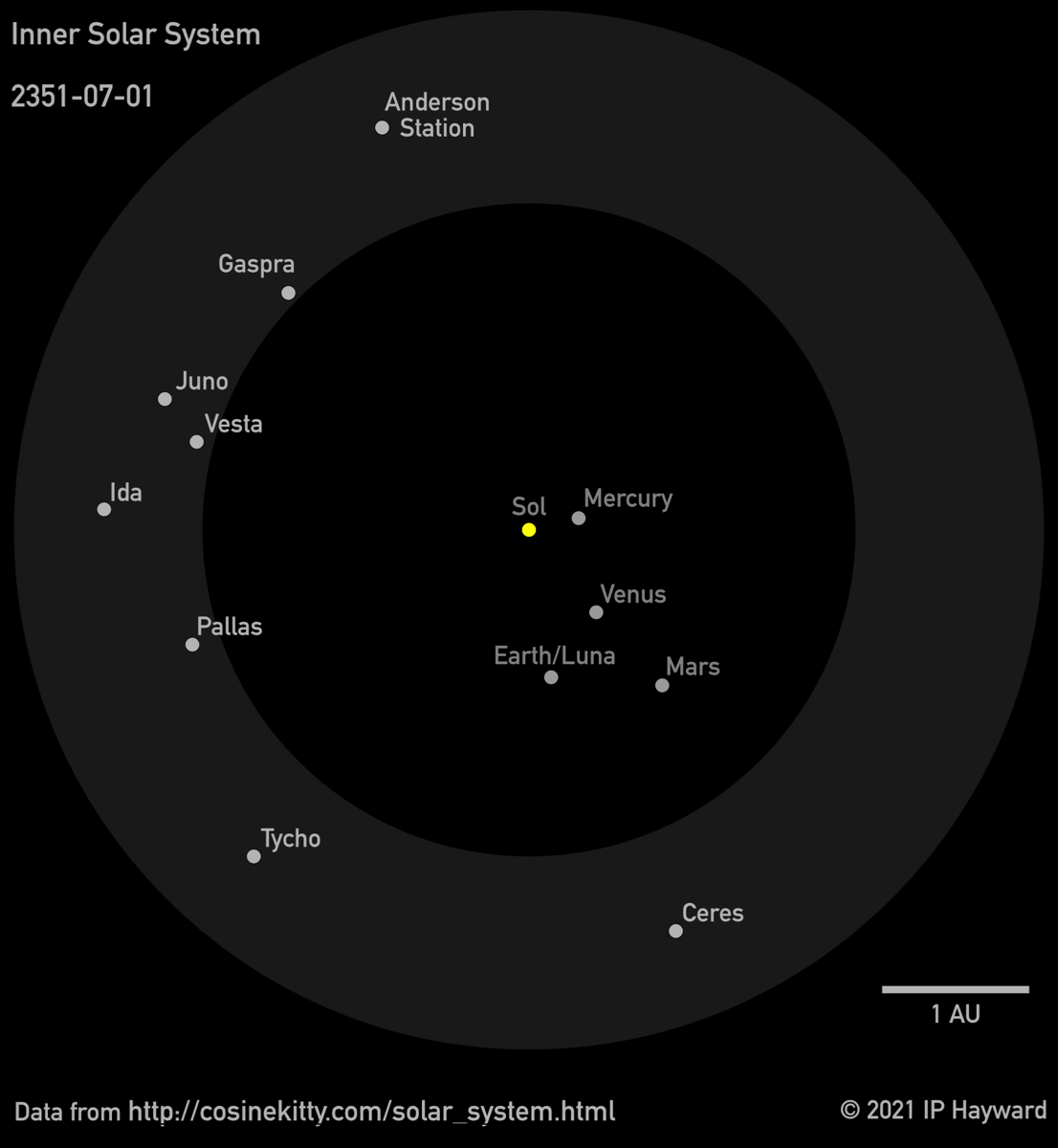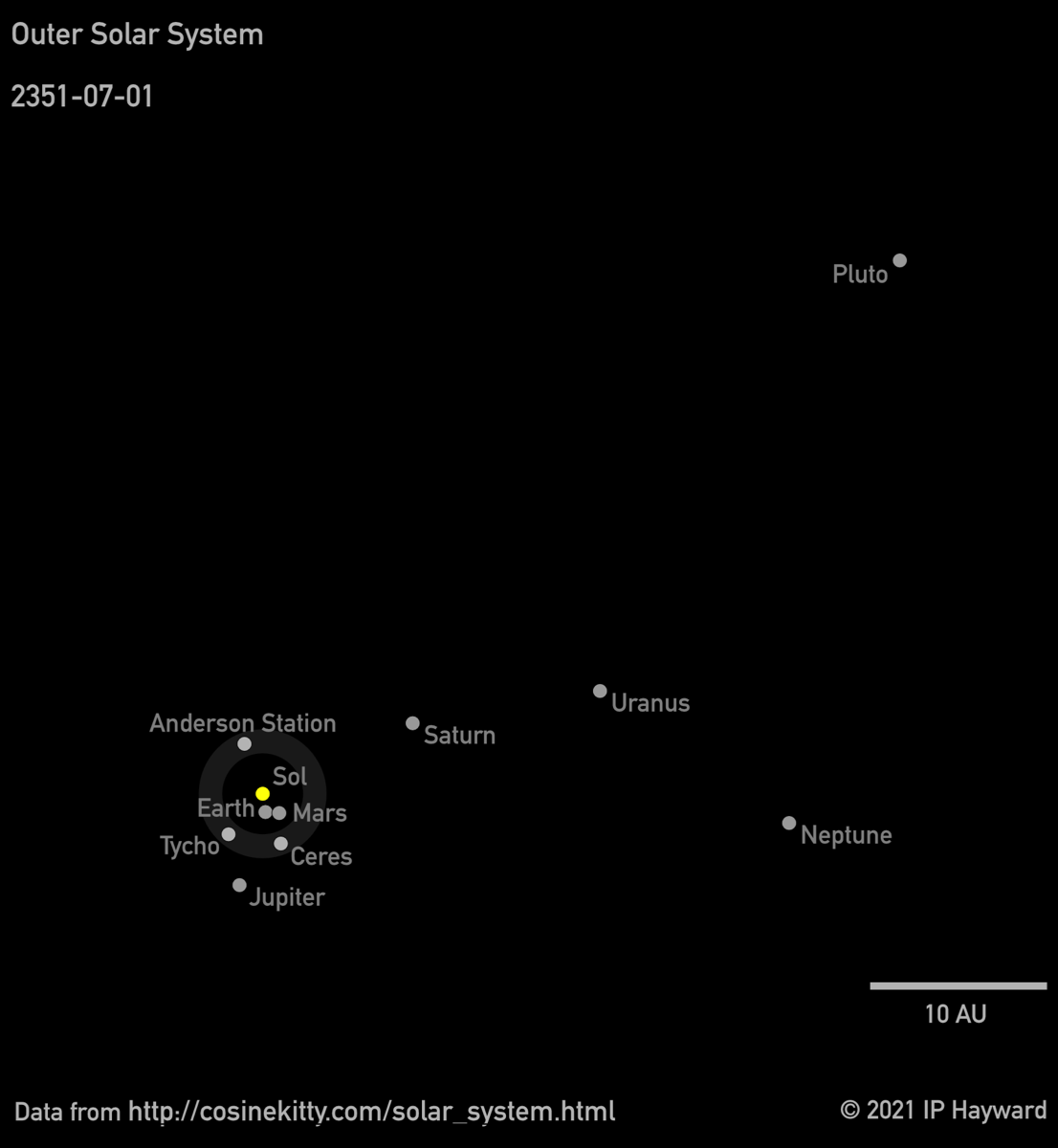The Expanse Role Playing Game


I am a big fan of The Expanse TV series and novels. Details:
I am running a role play game of The Expanse using a combination of Green Ronin's rules and Those Dark Places.
This page will hold any supporting documents and comments.
Tools
Spin gravity calculator
Burn calculator
Solar system in 2351 (2D map version)
Solar system in 2351 (3D map version)(may not work well on phones and tablets…if so, use the 2D version).
Burn calculator
Solar system in 2351 (2D map version)
Solar system in 2351 (3D map version)(may not work well on phones and tablets…if so, use the 2D version).
Notes
Anderson and Tycho
Anderson and Tycho Stations are assumed to be on the same orbit as Ceres, with Anderson opposite Ceres, and Tycho at a Ceres Lagrange L4/L5 point.
Travel times (Solar system in 2351 calculators)
Travel times are calculated assuming the same acceleration and burn times for both acceleration and deceleration, and no intermediate coast. If you want to use a coast, you will have to manually enter the distance into the Burn calculator.
Diagrams
Inner Solar System in 2351
Outer Solar System in 2351
Other information
Also have a look at the excellent https://transfercalculator.com. And check out the Easter egg instructions!
All the content below relates to my older spreadsheet versions, now replaced by the online calculators.
Expanse Travel Calculator, combined version (now replaced by the online calculators, above).
I have merged the two travel calculators into one.
Expanse Travel Calculator, 2351 edition (legacy version, now incorporated in the combined version, see above)
This is a new version of the Expanse Travel Calculator. Unlike the version listed below (which uses average positions of the celestial objects) this one uses the values from the 2351 distance calculator (also below).
You will probably have to fiddle with it a bit to get it to look nice in Excel.
You will probably have to fiddle with it a bit to get it to look nice in Excel.
Expanse Distance Calculator (legacy version, now incorporated in the combined version, see above)
The Expanse Distance Calculator spreadsheet contains distances for the major planets and asteroids in 2351.
Expanse Travel Calculator
The Expanse Travel Calculator spreadsheet contains my versions of the distances between places of interest, and a trip time calculator. Details of the calculations and tips on use are found in the Notes tab of the spreadsheet, and are replicated below.
Distances
Distances are calculated with the help of this article: https://physicstoday.scitation.org/do/10.1063/PT.6.3.20190312a/full/
All orbits are assumed circular.
Anderson and Tycho Stations are assumed to be on the same orbit as Ceres, with Anderson opposite Ceres, and Tycho 15 light minutes from Ceres.
I used this site to help me with the elliptic integrals: https://keisan.casio.com/exec/system/1180573458
If you want to use real distances, I can recommend https://www.wolframalpha.com/input/?i=+distance+from+earth+to+mars+15%2F8%2F2215.
You will need to know the date that the Expanse is set, and keep track of time. See: https://scifi.stackexchange.com/questions/156761/when-does-the-expanse-take-place
Travel times
Travel times are calculated assuming the same acceleration and burn times for both acceleration and deceleration, with an intermediate coast, if that is necessary to reach the destination.
Cell colours
Cells with red text are for data input.
Do not edit any of the other cells.
Cells with white text and a red background are warnings (see below).
How to use the TRAVEL TIME calculator
Select the departure and destination locations in the ‘From’ and ‘To’ cells.
Set the acceleration in ‘Accel, a’ and the duration of burn in ‘Taccel, ta’.
‘Tcruise, tc’ gives the duration of the cruise period of the trip.
‘Total, t’ gives the total duration (i.e. acceleration period plus coast period plus deceleration period).
‘Propellant’ indicates how much propellant is used in units of acceleration * time (ie. delta v)
‘Fraction’ indicates what fraction of the ship’s propellant is used on the trip."
How to use the TRAVEL TIME (GENERIC) calculator
This is very much like the TRAVEL TIME calculator except, instead of selecting the departure and destination, you just enter the total distance to travel.
How to use the TRAVEL TIME (NO COAST) calculator
Enter the total distance and the acceleration. This will calculate the total time, assuming you are doing no coasting, just doing a burn-flip-burn.
Ship parameters
This contains information on the amount of burn and duration of burn the ship can do on a full tank of propellant.
It is pre-populated with values for the Rocinante, based on a comment by Alex, along the lines of “the Roci can pull 0.3 g for about 4 weeks”.
I am assuming a inverse relationship between acceleration and burn duration. So the Roci can pull 0.3 g for 28 days, or 3 g for 2.8 days, etc.
The engine is probably less efficient at higher accelerations, but I haven’t tried to factor this in.
You will have to guess the values for other ships.
‘Tcruise’ warning
If the ‘Tcruise’ cell goes red, it indicates that a negative Tcruise has been calculated. This occurs when the acceleration and its duration are too large and you would overshoot the destination. Reduce ‘Accel’ and/or ‘Taccel’ until the ‘Tcruise’ cell is no longer red.
Fraction’ (Propellant) warning.
If this cell goes red, it indicate you do not have enough propellant to reach your destination. Reduce ‘Accel’ and/or ‘Taccel’ until the cell is no longer red.
Comparison with distances in the rules
How do these value compare with the rules?
Distances are very different. This is a consequence of the arguments given in https://physicstoday.scitation.org/do/10.1063/PT.6.3.20190312a/full/."
See, for example, Pluto to Neptune. In the rules it is 9.42 au. Here it is 45.6 au. It could be that the rules authors took the average distance between the two planets over the duration that the expanse is set.
However, this (https://www.wolframalpha.com/input/?i=+distance+from+neptune+to+pluto+01%2F07%2F2350) would suggest that the distance then is about 33 au.
Comparison of travel times with the rules
Consider a trip from Earth to Jupiter (4.2 au in the rules).
The rules give travel times of:
257 hours at 0.3 g; 141 hours at 1 g; 53 hours at 7 g; 41 hours at 12 g.
Using the parameters for the Rocinante, this spreadsheet predicts (for 4.2 au):
257 hours at 0.3 g; 141 hours at 1 g; 53 hours at 7 g; 41 hours at 12 g.
Note: the two calculations are in good agreement (because none of these burns uses all the Roci’s propellant (the 12 g burn uses 69%)."
Consider now a trip from Earth to Pluto (38.53 au in the rules).
The rules give travel times of:
778 hours at 0.3 g; 426 hours at 1 g; 161 hours at 7 g; 123 hours at 12 g
(32.4 days, 17.8 days, 6.7 days, 5.1 days, respectively).
Using the parameters for the Rocinante, this spreadsheet predicts (for 38.53 au):
32.4 days at 0.3 g (35% propellant); 17.7 days at 1 g (63% propellant); 7.6 days at 7 g (100% propellant); 6.8 days at 12 g (100% propellant)."
So, for the 7 g and 12 g burns, the Roci has to coast for the middle section of the trip. She will achieve the same maximum speed in both cases, but will get to Pluto faster with the 12 g burn because she will hit that maximum speed faster, and maintain it for longer, than in the 7 g burn case.
Miscellaneous
This spreadsheet was developed in Apple’s Numbers application. It may have a few rough edges when converted to Microsoft Excel. I have tried as best as possible to structure it in Numbers to minimise any problems.
